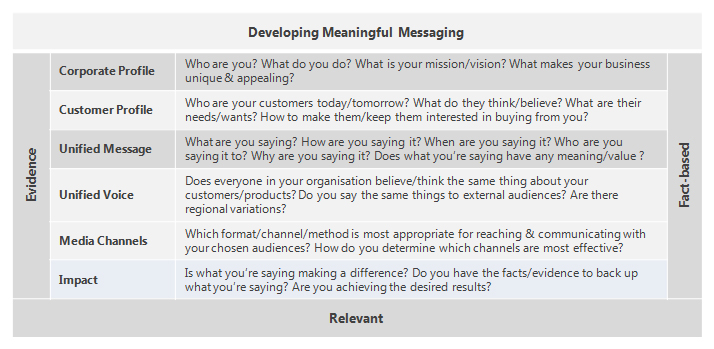IS ANYONE LISTENING?
Businesses are rightly placing increased emphasis on positioning, messaging and propositions in today’s ‘always on’ world of communication. Marketing, sales and product teams are presented with a plethora of communications vehicles, systems, practices and processes as a means to identify, acquire, engage and retain their customers’ attention and their business.
Determining the best communications approach requires a solid understanding of and insight into current market trends and customer needs. So often companies fall into the trap of believing their own hype without taking the time to consider its relevance and value to potential or existing customers.
Corporate, product, or sales messages must strike the right balance between what a company wants to say about itself and how well messages may be received, interpreted, and understood by recipients – be that an external or an internal audience.
The power of social media coupled with one-click access to information about your company, its products and its people means that you have to think very carefully about what you’re saying, to whom, when, how and why. Too many times we’ve seen companies wholeheartedly embrace social media communications vehicles, spurred on by the belief that such approaches are more cost effective than traditional marketing communications techniques without having first worked out whether these are appropriate for their audiences.
Our view is that social media is but one aspect of a company’s PR and communications strategy. Rather than a case of ‘either/or’, driven by the need to reduce costs, such methodologies must blend with and enhance traditional communications techniques in order to be successful.
It’s also important to align the message to the media. Knowing when to deliver a sound bite versus an in-depth research study. When to Tweet, when to blog, when to present, when to exhibit, when to demonstrate, when to promote, when to respond …… the options are endless. Encourage audiences to want to interact and engage with you. Be brave, be controversial, but be prepared to back it up with evidence, reference points and proof. And, always leave your audience wanting more!
The diagram below outlines the key elements to consider when developing corporate positioning and messaging strategies:
 From corporate branding to product positioning through to sales and customer service, it’s vital to ensure your messages are conveyed through the full duration of the customer life cycle; at every phase of customer engagement and contact, in order to create impact and generate results. This calls for marketing, sales, service and support to be fully aligned and conversant with a company’s positioning, messaging, PR activities and communications strategies.
From corporate branding to product positioning through to sales and customer service, it’s vital to ensure your messages are conveyed through the full duration of the customer life cycle; at every phase of customer engagement and contact, in order to create impact and generate results. This calls for marketing, sales, service and support to be fully aligned and conversant with a company’s positioning, messaging, PR activities and communications strategies.
Inconsistent, unsubstantiated communication only leads to confusion and scepticism in the minds of customers. Buying decisions may be deferred and, in the worst case, business may be lost to the competition.